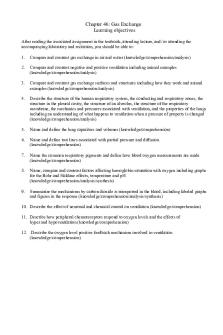Bio291 r2 ch.23 animation worksheet gas exchange PDF

| Title | Bio291 r2 ch.23 animation worksheet gas exchange |
|---|---|
| Author | Nique Johnson |
| Course | Anatomy And Physiology Ii |
| Institution | University of Phoenix |
| Pages | 6 |
| File Size | 308.7 KB |
| File Type | |
| Total Downloads | 34 |
| Total Views | 147 |
Summary
Lab results for assignments. homework and study notes....
Description
Gas Exchange To complete this worksheet, select: Module: Respiratory System Activity: Animations Title: Gas Exchange Introduction
1. a. Describe the respiratory system role with oxygen and carbon dioxide. The respiratory system is responsible for movement of gases involved in cellular metabolism.
b. Why is oxygen needed? Oxygen is needed and used during aerobic breakdown of glucose. c.
What generates CO 2? Carbon Dioxide is generated during the aerobic breakdown of glucose and other fuel molecules in order to produce ATP.
2. Define the three important continuous physiological processes that are responsible for the movement of oxygen and carbon dioxide. Ventilation Ventilation moves gases in and out of the lungs.
Gas Exchange Gas Exchange is the movement of gases in and out of the blood. This happens at the lungs external respiration and at the tissues internal respiration.
Gas Transport Gas Transport is when blood gases are transported to the lungs. Blood gases are transported to the organs and tissues throughout the body.
Gas Exchange 3. Explain the correlation between gas pressure and concentration. The direction that gas moves depend on the concentration of that gas. A gas within a compartment exerts pressure that is proportional to the concentration of that gas. Gas molecules move dow their pressure gradient.
4. a.
Define partial pressure. In a mixture, each individual gas exerts a pressure that is proportional to the concentration of that gas within the mixture.
b. Describe how partial pressure determines movement of specific gas molecules in a mixture. A gas moves along the part of the pressure gradient determined by its own concentration.
c.
Why would oxygen diffuse into this blood vessel while carbon dioxide diffuses out? Gas molecules diffuse from regions of higher pressure. Higher concentration to regions of lower pressure (lower concentration).
5. Contrast External and Internal respiration. During external respiration at the lungs, gas exchange occurs between the alveolar a blood compartments. During internal respiration, at the systemic tissue cells, gas exchange occurs between the blood and systemic compartments.
External Respiration
6. Define external respiration. External Respiration is the gas exchange between the alveolar spaces in the lungs and the blood in pulmonary capillaries. 7. What is the critical function of ventilation? Ventilation brings air in that is rich in oxygen, this goes to the alveolar spaces in the lungs.
8. a.
Contrast the P02 (oxygen partial pressure) in the lungs (alveoli) and in the surrounding blood capillaries. Alveolar air oxygen partial pressure is higher in the lungs and lower in the surrounding capillaries.
b. Contrast the PCO2 (carbon dioxide partial pressure) in the lungs (alveoli) and in the surrounding blood capillaries. Carbon dioxide partial pressure is lower in the lungs and higher in the surrounding blood capillaries.
c.
Gas diffusion is dependent upon the partial pressure of gasses. Explain the movement of the following gasses between lung alveoli and blood capillaries as a function of their relative partial pressures in each location. Oxygen - Oxygen moves from the alveolar compartment to the capillary compartment.
Carbon Dioxide – Carbon dioxide moves from the capillary compartment to the alveolar compartment.
Internal Respiration 9. Define internal respiration. The gas exchange between the systemic blood capillaries and tissue cells.
10. a.
Contrast the P02 (oxygen partial pressure) in the blood capillaries and in the cells of the surrounding tissues. The blood near the tissues has a higher oxygen partial pressure. Blood in the surrounding tissues has a lower oxygen partial pressure.
b. Contrast the PCO2 (carbon dioxide partial pressure) in the blood capillaries and in the cells of the surrounding tissues. The blood near the tissues has a lower carbon dioxide partial pressure. Blood in the surrounding tissues has a higher carbon dioxide partial pressure.
c.
Explain the movement of the following gasses between blood capillaries and tissue cells as a function of their relative partial pressures in each location.
Oxygen - Oxygen moves from the capillary blood compartment to the cell compartment.
Carbon Dioxide – Carbon dioxide moves from the cell compartment to the blood in the capillary compartment....
Similar Free PDFs

Bio291 r2 ch - Worksheets
- 17 Pages

Gas Exchange
- 11 Pages

Gas Exchange concept notebook
- 4 Pages

Impaired gas exchange- Biology
- 7 Pages

Gas exchange and adaptations
- 8 Pages

Chap 46 Gas Exchange-SM17
- 17 Pages

Lecture 8 Gas Diffusion Exchange
- 23 Pages

Ch23
- 47 Pages

Gas Stoich Worksheet + Solutions
- 3 Pages
Popular Institutions
- Tinajero National High School - Annex
- Politeknik Caltex Riau
- Yokohama City University
- SGT University
- University of Al-Qadisiyah
- Divine Word College of Vigan
- Techniek College Rotterdam
- Universidade de Santiago
- Universiti Teknologi MARA Cawangan Johor Kampus Pasir Gudang
- Poltekkes Kemenkes Yogyakarta
- Baguio City National High School
- Colegio san marcos
- preparatoria uno
- Centro de Bachillerato Tecnológico Industrial y de Servicios No. 107
- Dalian Maritime University
- Quang Trung Secondary School
- Colegio Tecnológico en Informática
- Corporación Regional de Educación Superior
- Grupo CEDVA
- Dar Al Uloom University
- Centro de Estudios Preuniversitarios de la Universidad Nacional de Ingeniería
- 上智大学
- Aakash International School, Nuna Majara
- San Felipe Neri Catholic School
- Kang Chiao International School - New Taipei City
- Misamis Occidental National High School
- Institución Educativa Escuela Normal Juan Ladrilleros
- Kolehiyo ng Pantukan
- Batanes State College
- Instituto Continental
- Sekolah Menengah Kejuruan Kesehatan Kaltara (Tarakan)
- Colegio de La Inmaculada Concepcion - Cebu






